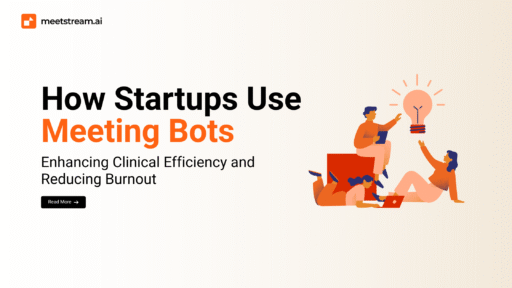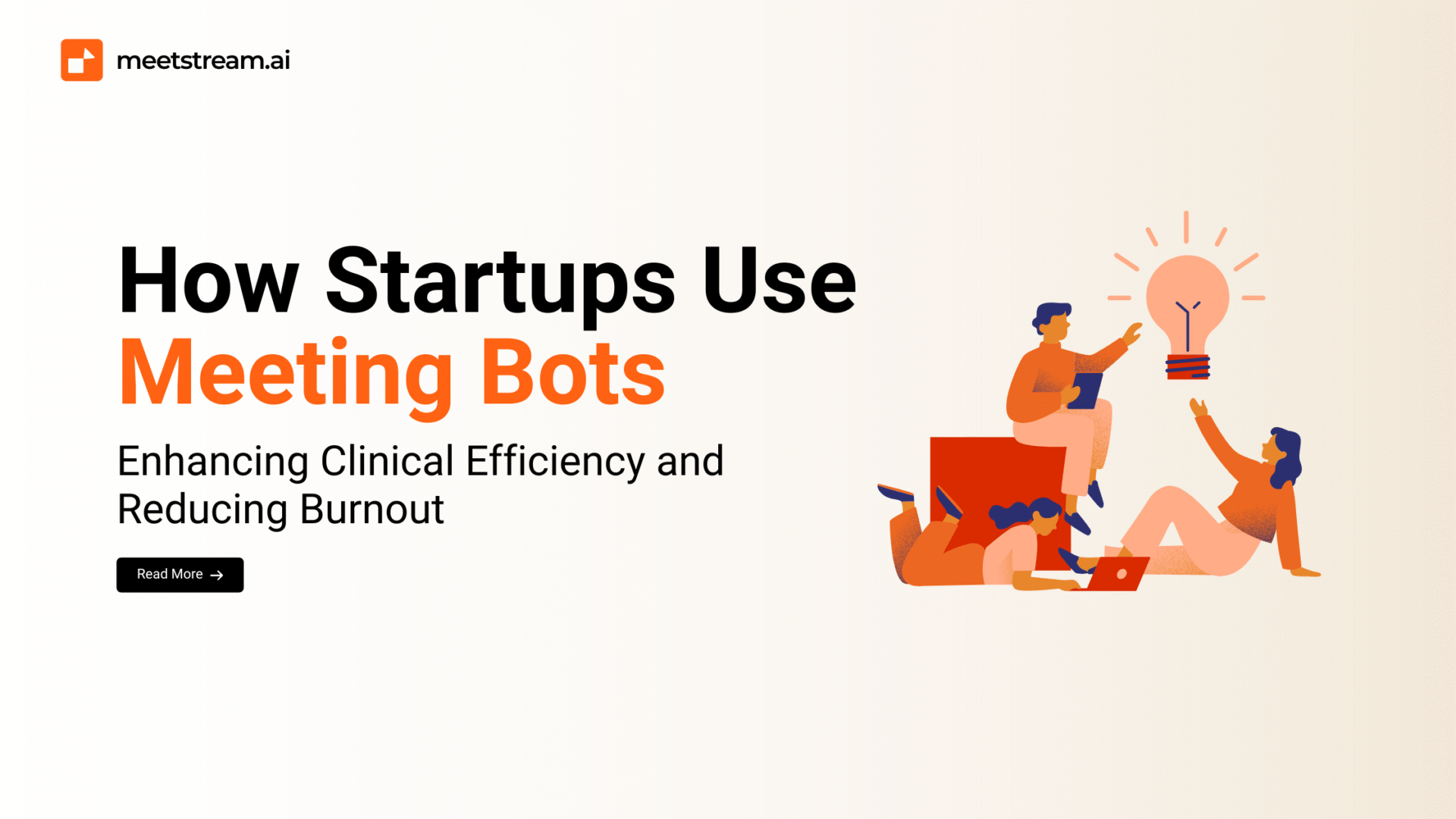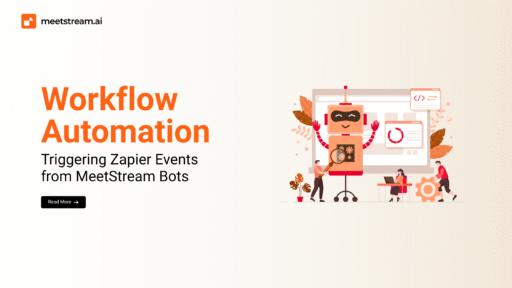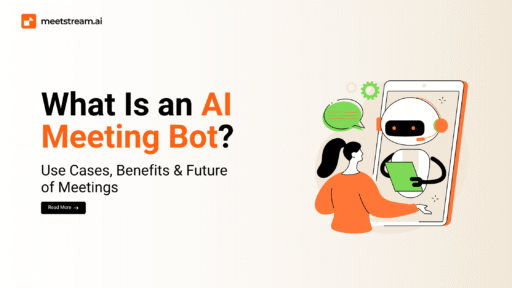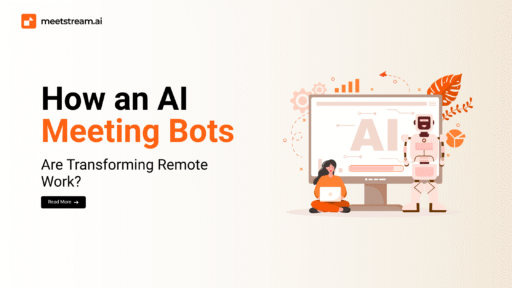Startups operate at a unique rhythm: fast, lean, and often unpredictable. Founders and early teams juggle high-stakes decisions, product iterations, investor conversations, and rapid pivots, sometimes all within the same day.
The pressure to move quickly without missing a beat is immense, and the consequences of miscommunication or forgotten details can derail momentum. Add to that the fact that most modern startups are remote-first or distributed across time zones, and the potential for context loss or misalignment only increases.
In this environment, the traditional approach of manual note-taking or relying on memory is no longer sustainable. Enter AI-powered meeting bots, smart virtual assistants that have quietly become essential to startup operations.
These tools automatically transcribe conversations, extract action items, and integrate meeting summaries into platforms like Slack, Notion, or project management tools. By capturing knowledge in real-time, they help startups maintain operational clarity without slowing down.
Why Meeting Bots Are a Startup Favorite
Startups love meeting bots for one core reason: they accelerate workflows without sacrificing clarity. Unlike larger enterprises with layers of support staff, early-stage companies operate with minimal resources.
There’s no dedicated notetaker in founder meetings, no formal process for documenting every customer conversation. Team members wear multiple hats, and meeting notes are often neglected or hastily jotted down if captured at all.
AI meeting bots step into this gap. These tools automatically record, transcribe, and summarize meetings, ensuring critical insights are not lost. This is especially valuable for startups that thrive on speed and agility, where missed context can lead to duplicated efforts or strategic missteps.
In remote and hybrid teams, where employees work asynchronously across time zones, meeting bots create a shared source of truth.
Instead of relying on someone to brief the rest of the team, bots generate consistent summaries that can be instantly distributed, allowing even those who couldn’t attend live to stay up to date.
This promotes asynchronous collaboration, reduces knowledge silos, and ensures continuity across product development, sales, hiring, and operations.
Moreover, in fast-moving environments where startups pivot frequently or make key decisions on the fly, meeting bots help document the decision trail.
Whether it’s a new feature direction, a last-minute investor update, or a hiring verdict, AI assistants provide traceability and accountability, something crucial for scaling teams and preparing for audits, due diligence, or growth reporting.
Key Startup Workflows Enhanced by Meeting Bots
1. Founders and Leadership Syncs
Startup founders often hold rapid-fire strategy sessions to discuss pivots, investor asks, or product directions. In these high-signal discussions, meeting bots like MeetStream.ai play a critical background role—quietly capturing every speaker’s contribution, timestamping key insights, and generating structured summaries.
MeetStream stands out with its unified API that connects seamlessly with Zoom, Google Meet, Microsoft Teams, and other platforms. Startups can deploy meeting automation without building custom integrations, enabling fast adoption across teams.
Its real-time speaker-labeled transcripts, delivered via secure webhooks or streaming, can be sent directly into productivity hubs like Notion or Slack. The result? Meetings that are automatically summarized, with action items assigned and next steps clearly documented.
This kind of tool turns chaotic brainstorms into searchable strategic archives, helping founders stay focused on vision execution while keeping everyone aligned.
2. Engineering Standups and Sprint Planning
Engineering teams rely on daily standups to sync progress and identify blockers. But manual updates or missed attendance can slow down progress tracking.
With meeting bots, updates are automatically captured and summarized, helping engineering leads quickly visualize sprint health, assign ownership, and reduce operational overhead.
For distributed dev teams, especially those working across time zones or freelancing, asynchronous recaps ensure that no voice is left unheard. This improves sprint velocity, enhances task accountability, and strengthens team alignment.
3. Customer Calls and User Research Sessions
Customer feedback is gold for any startup. Product managers and UX teams spend hours on Zoom calls gathering insights, but sifting through recordings to find useful takeaways is tedious.
Meeting bots solve this by transcribing interviews, tagging feature requests, and surfacing usability issues.
Over time, this voice-of-customer data can be categorized and used to influence product roadmaps, validate design decisions, or build case studies.
When integrated with CRMs or product analytics platforms, these insights also provide data-backed context to marketing and sales teams, enabling more targeted campaigns or onboarding flows.
4. Investor and Board Meetings
Investor meetings are high-stakes and fast-moving. Questions fly, metrics are scrutinized, and founders need to convey clarity under pressure.
Meeting bots provide a reliable record of everything discussed, from growth projections to fundraising milestones.
After the meeting, these bots generate polished summaries that can be shared with stakeholders or saved for internal alignment.
This enhances transparency, follow-through, and trust, particularly during Series A or B fundraising, when due diligence requires detailed meeting histories.
Bots also help reduce founder stress: rather than scrambling to document what was said, they can focus on delivery and reference accurate records later.
5. Hiring Interviews and Candidate Evaluations
Startups move fast when hiring. With multiple panel interviews and fast feedback loops, it’s easy for details to get lost or for biases to creep in. AI meeting bots record and summarize interviews, providing objective documentation that hiring teams can refer to.
These tools help standardize candidate evaluations, reduce repetition across rounds, and ensure that hiring decisions are made with full context and fairness. Over time, startups build a searchable archive of past interviews, helping streamline future hiring and reduce onboarding friction.
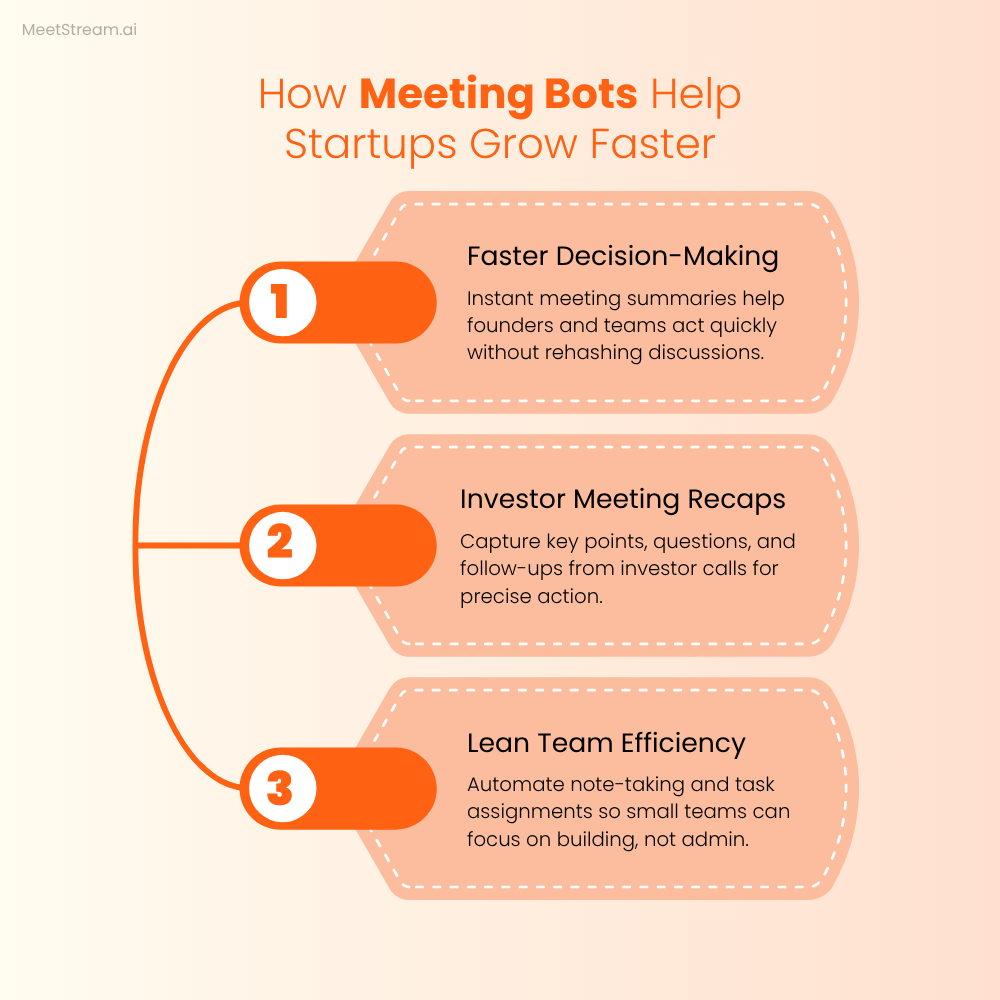
Benefits of Using Meeting Bots in Startup Operations
Meeting bots are transforming the way startups operate not just by saving time, but by elevating how teams communicate, collaborate, and capture knowledge.
Below are the key operational benefits startups gain when integrating AI meeting assistants into their daily workflows.
1. Save Time and Eliminate Cognitive Overload
In a fast-paced startup environment, every minute counts. Founders and team leads are often jumping between product discussions, sales calls, and investor updates.
In such high-stakes settings, manually jotting down notes can slow down the pace and disrupt the flow of critical conversations.
Meeting bots remove this bottleneck by automating transcription and note-taking in real-time. They capture everything from casual brainstorming to strategic decisions allowing participants to stay fully engaged without the mental burden of remembering who said what.
This reduces context-switch fatigue, frees up cognitive capacity, and enables faster decision-making without sacrificing documentation.
2. Strengthen Alignment Across Remote and Distributed Teams
Startups today are increasingly remote-first, with team members often spread across cities, countries, and continents. Miscommunication and context loss are common when people work asynchronously or join calls in different time zones.
Meeting bots bridge this gap by delivering consistent, context-rich meeting summaries to all team members, regardless of location.
Whether someone missed the call due to time zone differences or joined mid-discussion, they can stay aligned by reviewing the bot’s generated summary.
This fosters transparency, autonomy, and faster onboarding for new team members all essential ingredients for scaling a distributed startup culture.
3. Build a Searchable Knowledge Base for Long-Term Clarity
Every conversation whether it’s a feature planning call or a customer feedback session contains valuable institutional knowledge.
But without a structured way to preserve that knowledge, insights often get lost in Slack threads, email chains, or people’s memories.
Meeting bots create a centralized, searchable archive of all recorded calls, making it easy to revisit specific decisions, feedback, or follow-ups.
Founders can quickly locate a product choice made weeks ago, or a designer can retrieve a user’s exact comment from a research call.
Over time, this evolves into a living knowledge repository that supports learning, alignment, and historical reference across the organization.
4. Improve Task Follow-Through and Project Execution
A recurring problem in fast-moving teams is that action items get discussed but not executed. People leave meetings with unclear responsibilities, or worse, no one remembers what was agreed upon.
AI meeting bots tackle this by automatically extracting tasks, assigning ownership, and integrating those action items into project management tools like ClickUp, Trello, Linear, or Asana.
This eliminates the manual step of translating discussion into execution. The result is better accountability, faster task kickoff, and smoother handoffs all critical for startups trying to ship fast and iterate often.
5. Enhance Investor and Stakeholder Communication
Early-stage founders are constantly communicating with investors whether in pitch meetings, quarterly reviews, or roadmap check-ins. These meetings are dense with KPIs, strategic updates, and high-level goals.
Meeting bots help by providing professional, timestamped summaries that founders can share with stakeholders.
This creates a transparent communication loop and shows operational maturity something investors deeply value.
When it’s time for due diligence or a follow-up funding round, founders can easily provide verifiable records of past commitments and discussions, reducing friction and building trust.
6. Enable Fast, Independent Onboarding for New Team Members
Startups often hire in bursts, and new hires need to get up to speed quickly without draining team bandwidth. Meeting bots serve as on-demand onboarding aids.
By giving newcomers access to prior meeting transcripts, product discussions, and user interviews, they can understand context, culture, and direction without requiring synchronous walkthroughs. This speeds up ramp time and allows teams to scale efficiently.
7. Preserve Organizational Memory as the Startup Grows
In the early days, it was easy for critical information to live in people’s heads. But as the company grows, unwritten decisions and undocumented knowledge can lead to confusion, duplicated efforts, or repeated mistakes.
By consistently capturing meetings and decisions, bots help startups preserve institutional memory.
This becomes especially valuable during leadership transitions, product handoffs, or technical refactors. It ensures that growth doesn’t come at the cost of losing what made earlier versions of the company successful.
Key Features Startups Should Look for in a Meeting Bot
Not all meeting bots are created equal. When selecting a solution for startup use cases, it’s important to focus on features that directly support agility, growth, and collaboration. Here are the core capabilities every startup should prioritize:
1. Accurate, Real-Time Transcription
At the foundation of any meeting bot is its transcription engine. The tool must deliver fast and precise transcripts, even with varied accents, overlapping voices, or technical jargon. Startups often discuss product architecture, fundraising strategies, or niche user feedback, so the bot must handle complex terminology and startup-specific vocabulary with ease.
Speaker identification is another must-have. In investor meetings, panel interviews, or all-hands calls, it’s crucial to know who said what. Bots should clearly label speakers and segment conversations for easy tracking.
2. Actionable Meeting Summaries
A transcription alone isn’t enough. A strong meeting bot must generate digestible summaries that extract key themes, decisions, blockers, follow-ups, and action items. These summaries should be flexible in format ranging from bullet-point lists to paragraph narratives depending on the audience or use case.
Startups need clarity at the end of every conversation. By offering structured post-meeting insights, bots empower teams to move faster with less ambiguity and more accountability.
3. Seamless Integration with the Startup Stack
A meeting bot should feel like part of your existing infrastructure, not an isolated tool that creates extra steps. Look for bots that integrate natively with Slack, Notion, Airtable, Trello, ClickUp, HubSpot, and CRMs. Even better, opt for bots that offer webhooks, APIs, or Zapier integrations, giving technical teams the ability to automate custom workflows.
This interoperability enables powerful automations, such as routing meeting transcripts into documentation hubs, syncing task assignments to project boards, or pushing investor insights into CRM pipelines.
4. Robust Privacy, Permissions, and Access Control
Startup meetings often involve sensitive discussions: equity splits, investor negotiations, go-to-market plans, or confidential hiring decisions. The meeting bot must offer granular access controls, encrypted storage, and clear distinction between internal and external sharing rights.
Founders should feel confident that their conversations are securely captured and shared only with intended recipients. Look for bots with SOC 2 compliance, role-based permissions, and audit trails for enterprise-grade trust.
Final Thoughts
AI meeting bots are no longer a “nice to have” for startups they’re a strategic must-have. In fast-paced, lean environments, they bring clarity, save time, reduce manual effort, and improve transparency. Whether you’re building a product, pitching investors, or hiring talent, bots cut through operational noise.
Deployment is effortless. Your team can launch meeting agents in minutes no transcription pipelines, no infrastructure headaches. MeetStream joins calls, records discussions, detects speakers, and delivers structured insights instantly.
If you’re not using meeting bots yet, you’re likely missing key decisions and wasting valuable time. MeetStream.ai gives your team a quiet co-pilot turning conversations into action, and meetings into momentum.
FAQs on How Startups Use Meeting Bots
Are AI meeting bots secure enough for sensitive startup meetings?
Yes. Most leading bots use encryption, offer granular access controls, and allow you to redact sensitive sections. Always check for SOC 2 compliance and end-to-end encryption.
Can bots summarize standups in Slack automatically?
Absolutely. Many meeting bots integrate with Slack to post daily summaries, blockers, and next steps, making them perfect for asynchronous team collaboration.
Do I need a paid Zoom or Meet plan for the bot to work?
Some bots work with free plans, but paid Zoom or Google Meet accounts typically offer better integration and higher-quality audio for transcription accuracy
Can bots summarize meetings in different languages?
Yes, multilingual support is increasingly common. Leading bots support transcription and summary in languages like Spanish, French, German, and more great for global teams.
Will bots integrate with my Notion or Airtable workspace?
Yes. The best bots sync directly with Notion, Airtable, and similar tools via native integrations or platforms like Zapier or Make.

